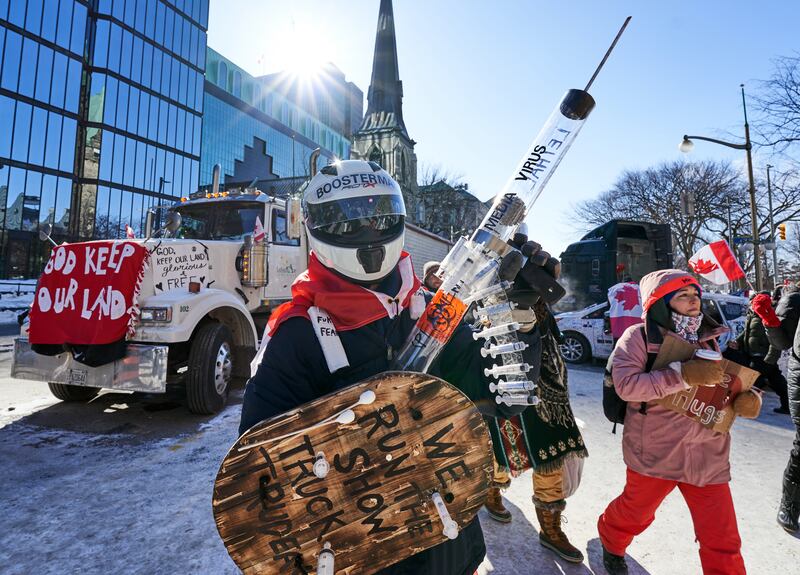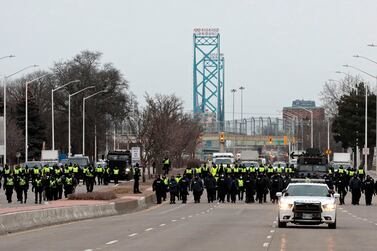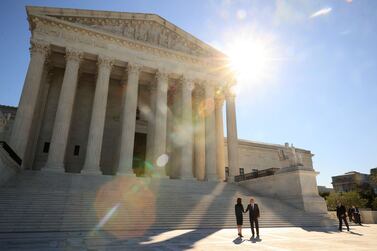Most of what the "freedom convoy" immobilising the Canadian capital Ottawa purports to be is false or phony.
This disruption cutting off crucial bridges and supply lines to the United States is supposedly protesting vaccine mandates. But that’s not the point. It is Canadian. But it’s also highly influenced and funded by the US ultra-right. The iconography, including Confederate battle flags and Nazi swastikas, amply illustrates that.
Most of the protesters are not truckers. And most Canadian truckers (over 90 per cent of whom are vaccinated), and certainly their outraged union, seem aghast at the disruption.
This is less a “protest” than an act of lawless economic vandalism promoting a topsy-turvy notion of “freedom”. It's also the latest instance of the western ultra-right taking on the worst trappings of the extreme left of the 1960s and '70s.
In the 20th century, it was typically the left that engaged in and celebrated disruption, takeovers, besieging the powerful, and attacking institutions and the police. Yet a series of events – the gilet jaune protests or the yellow vest movement in France (which never really found a focus), the attack on the Michigan state house in April 2020, the January 6 insurgency at the US Capitol building, and now this radical disruption in Canada – show how thoroughly such tactics are being adopted by the extreme right.
What's emerging is a template for how relatively small groups, just a few hundred people, can immobilise western capitals, disrupt trade, cut supply lines and terrorise society. The point is the one I have been identifying time and again in these pages: the western and American right is now firmly focused on attacking the state in virtually all its forms.
It is notable that the grievances are typically inane. If the 2020 US election really was “stolen,” why did Democrats hand themselves significant congressional defeats? If the Canadian protests are about vaccination requirements, why aren't they targeted at provincial authorities, responsible for such rules in Canada, or the US, which has long-imposed a vaccination requirement for crossing the border?
Attacking the state is the only thing that renders any of this coherent. As political scientist Timothy Snyder notes, “senselessness... is part of the point. Making demands that cannot be met makes it hard to bring the chaos to an end.”
The anarchism, countercultural rage and absolute opposition typical of the far-left between 1965-1975 is now primarily a tool of the ultra-right. Even the hippie aesthetic can be readily seen in, for example, the famously outlandish bearded and horned "QAnon Shaman", the most memorable figure from the January 6 insurgency.

He would have raised no eyebrows at Woodstock. Neither would the right’s new-found passion for homeopathic medicines, weird drugs like hydroxychloroquine, or deep hostility to medical authorities, the pharmaceutical industry and science in general.
To the contrary, it would have fit right in. Conservatism, meanwhile, has disappeared.
Yet the Ottawa protest was hardly ad hoc. It was not only well-funded by US radicals, the instigator, James Bauder, is a noted QAnon and conspiracy theorist who calls Covid-19 “the biggest political scam in history”.
It reportedly involves former Canadian police and military personnel who set up ingenious, complex supply chains to keep the disruption going by funnelling fuel, food and comforts to protesters.
It is a sophisticated operation, provincially, nationally and internationally. Yet the state response has also been quite sophisticated.
Canadian authorities were caught off guard and evidently unprepared. However, both the provincial and national authorities have understood this was, above all, a provocation. The organisers sought an overreaction by the government, precisely because they are attacking the state itself.
Therefore, while it has been frustrating for many Ottawa residents, other Canadians and reasonable people everywhere, the authorities were wise to keep a low profile and not rise to the bait by overreacting.
Canadian premier Justin Trudeau leads an unpopular government, so he was wise to tread carefully. But beyond that, while many elements of the Canadian political right at first were tempted to side with the disruption, the restraint by the authorities effectively made most such open sympathy politically untenable.
The protesters were allowed to have their say, even at the cost of many millions of dollars and massive public dislocation and frustration. Few have been arrested and there has been no crackdown. Instead, the protest was given the space to overplay its hand, which it did.
Angry public opinion forced right-wing Canadian politicians such as Ontario Premier Doug Ford to eventually side with the public and the state, against the protesters. In effect, by taking a light touch, the Canadian state allowed the "freedom convoy" to paint itself, and not the authorities, as the bullies.
Yet the template for how small numbers of fanatics can cause havoc in major western cities has been reaffirmed. Copycat efforts are inevitable, and there are numerous reports of American groups preparing to mimic exactly this tactic.
They already have cheerleaders. In the US, many Fox News hosts have been lauding the Canadian truck protests, as has former president Donald Trump. Ultra-right Senator Rand Paul encouraged American extremists to pull similar stunts in Washington DC and elsewhere in the US.
Again, this expresses the sentiment of being at war with the state itself – and arguably even society in general. As Michael Gerson, a former speechwriter for Republican president George W Bush, explained: “Support for seditious acts is now a normal and accepted element of Republican identity.”
This war has become definitional for the new right, just as it was for radical parts of the "new left" in the 1960s. It is impossible to imagine President Joe Biden or other senior Democratic Party leaders chanting "burn, baby, burn," or supporting violent attacks on the police. But many major Republican Party figures have increasingly been embracing exactly those attitudes.
That's the biggest difference.
The far-left of the 1960s-1970s never made many inroads in the Democratic Party or came close to seizing its leadership. Yet the Republican Party has unquestionably suffered an increasing extremist take-over, with the Senate old guard and a few governors as the last holdouts.
Such attacks and disruptions are likely to happen again in the US and elsewhere, with some key political leaders on the right cheering. But the Canadian experience shows the wisdom, when possible, of not taking the bait and instead giving such provocateurs the space in which to overplay their hands.







